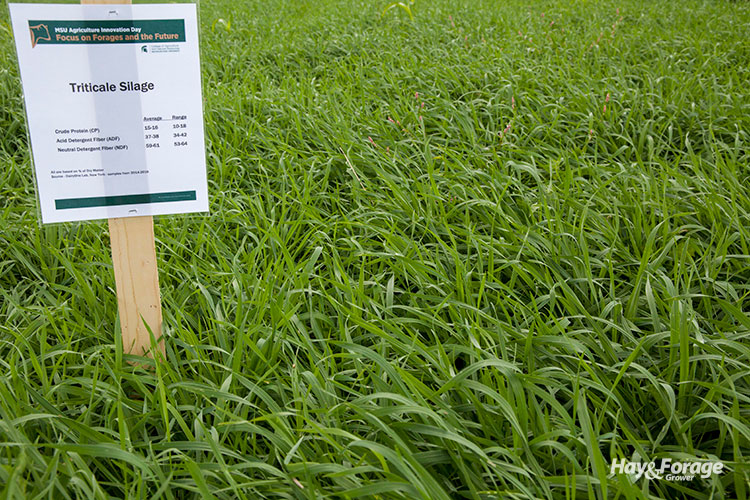
Every year, we see new ideas come down the pike. Time, of course, is the best measure of success for any new idea or technology. If something doesn’t work, its staying power is usually short.
Of course, every now and then, something “new” comes along that seems to offer benefits and slowly gains in popularity. I think we can now put triticale in that category; its acres continue to grow with each passing year.
Interestingly, the use of triticale is not limited to one region, which is a testament to its environmental versatility. It is being planted more routinely from the Northeast to Florida to California’s Central Valley. The varieties might be slightly different, but the benefits remain the same.
Although rye and wheat are still widely grown in the world of winter cereals, triticale is now mentioned in the same breath. Ironically, triticale is derived from crossing wheat and rye.
Triticale, like other winter annuals, isn’t bulletproof, but it does provide a low-risk opportunity to obtain additional forage that is both high in yield and quality.
On dairy farms across the country, triticale is being harvested as silage in the spring. It also offers one more means to apply and utilize manure both before seeding in the fall and after the spring harvest.
In the Southeast, beef producers are using triticale in their winter pasture mixes for early winter and spring grazing. It fits well with ryegrass and other winter cereals, according to Ann Blount, a University of Florida plant breeder. The crop is also cut in the spring and made into baleage.
In the North, the optimum seeding time is quickly approaching. To get the most from winter triticale as a forage crop, keep these five keys to success in mind.
Variety selection
New varieties generally get developed and released because they’re better than the existing, older varieties. Triticale is no different.
Where triticale varieties have been tested for forage yield and quality differences, the superior performance of newer varieties is apparent. Research has shown that new, adapted triticale varieties will meet or exceed the yields of other cereal forages. Many universities are now testing triticale along with wheat and rye. Planting certified, weed-free seed of known germination percentage and purity will always pay dividends.
Plant early
New York crop consultant and independent researcher Tom Kilcer routinely stresses the importance of an early planting date to promote top and root growth along with fall tillering.
He suggests seeding triticale 10 days to two weeks ahead of the recommended winter wheat planting date for a particular area. In his research, a 10-day difference in planting date has sometimes resulted in a 30% or more difference in yield the following year. Kilcer notes that earlier planting is most critical in Northern regions.
In the Southeast, triticale is planted in October through December, depending on location and weather conditions.
Not too shallow
Kilcer also suggests planting triticale seed 1.25 inches deep. Shallower planting depths predispose the plant to winterkill and heaving. Use a grain drill with press wheels so that seed placement can be controlled. There will be a much greater likelihood for success by drilling compared to broadcasting the seed followed by light tillage.
It needs nitrogen
Winter annuals such as triticale will take up nitrogen in the fall and keep it from leaching through the soil profile. Because fall tillering is important to maximize yield in early plantings, triticale will generally need some nitrogen applied in the fall. This can be in the form of manure or commercial fertilizer. Supply about 50 to 60 pounds of nitrogen per acre.
An additional application of nitrogen in the spring will help promote spring tillering and also may improve the crude protein content of the forage. Triticale is less prone to lodging than winter rye.
Yield or quality?
Like most forage crops, there is going to be a yield-quality trade-off with triticale. Dairy farmers typically sacrifice yield for higher quality forage. At the same time, it also allows them to follow the harvest with a timelier spring planting of corn or sorghum.
To achieve high-quality triticale forage, it needs to be cut in the flag leaf to boot stage (prior to heading). Yields can be quite variable depending on all of the production practices discussed previously but are often cited in the range of 2 to 4 tons of dry matter per acre.
A delayed harvest at the soft-dough stage will boost yields by more than 50%. Such a harvest strategy will also reduce forage quality significantly and eliminate the option of planting another full-season crop, at least in the North. Both of these factors are strong deterrents to employing a delayed harvest.
Triticale is providing many dairy and beef producers additional high-quality, harvested feed or grazed forage with very little risk. It fits well into most crop rotations and provides multiple environmental benefits in the form of reduced soil erosion and additional nitrogen uptake. At this point, it doesn’t look like triticale will be leaving the landscape any time soon.

